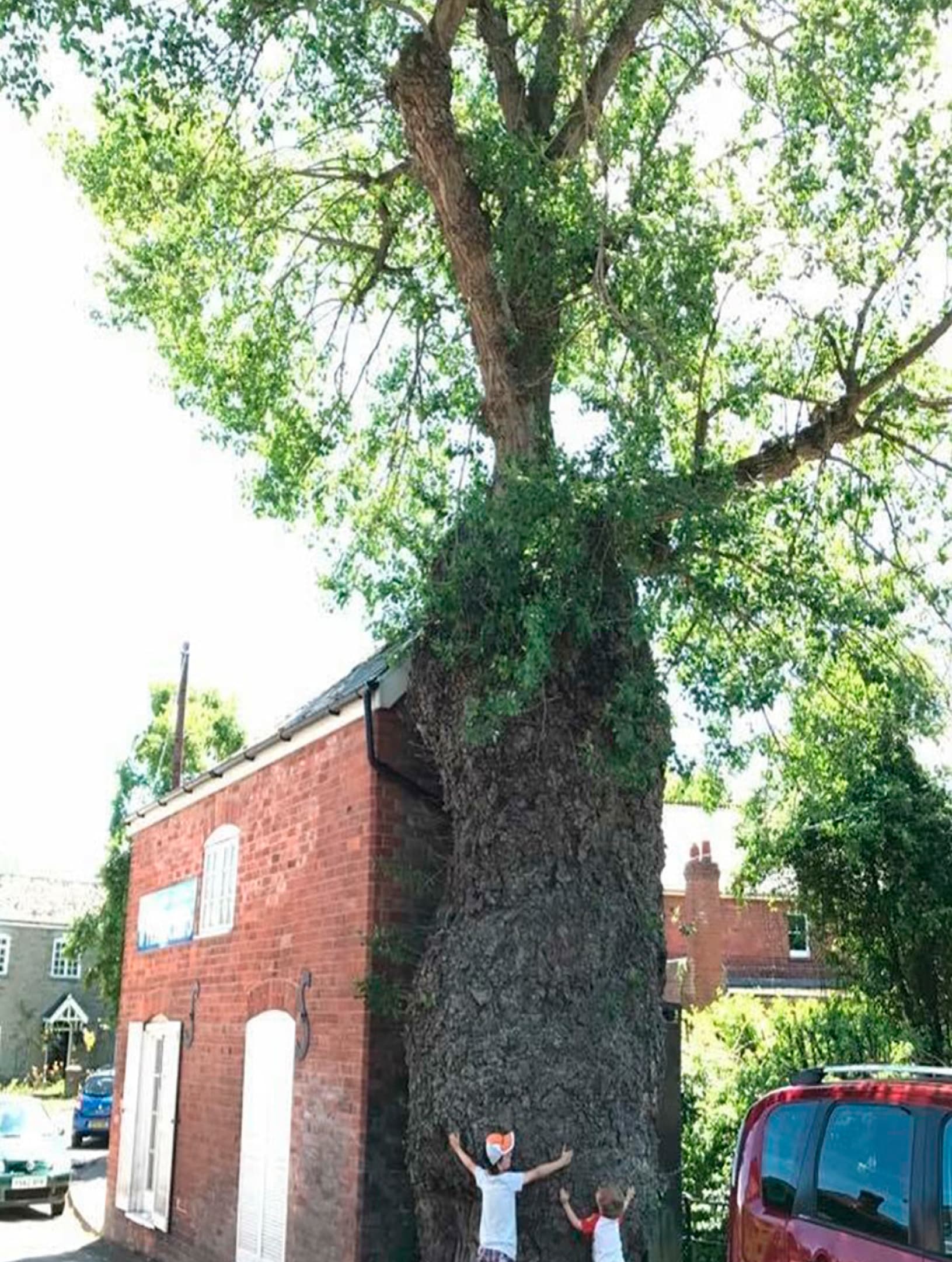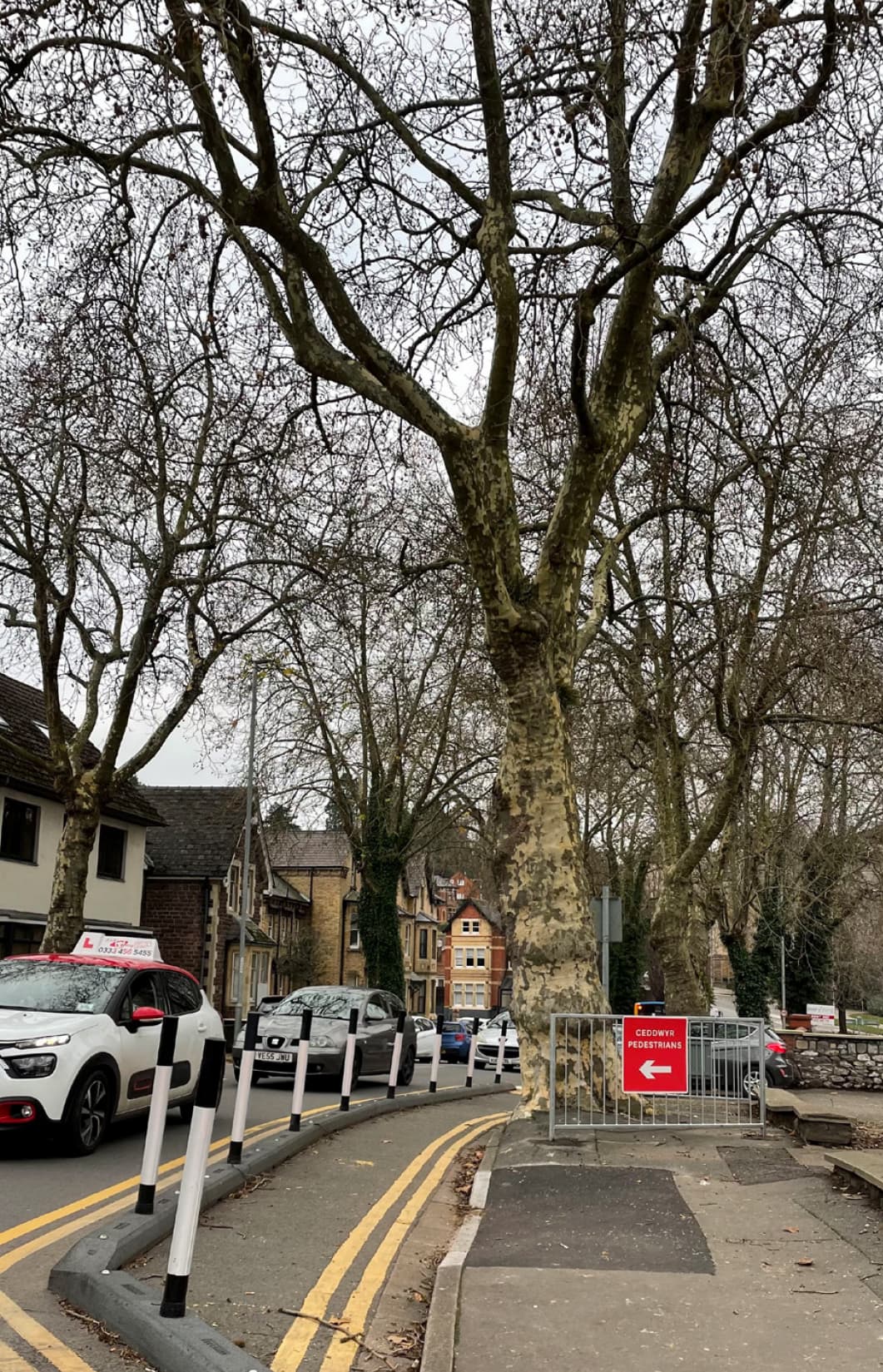Neil Davies
Like many arboriculture professionals, even after 25 years in the industry, I still have questions about trees that I don’t know the answer to.
While surveying street trees recently a thought occurred to me that although there is great work being done across the country to retain and maintain our urban street tree stock, are there any long (really long) term plans for them? If we are to retain these wonderful green assets, they will, by their nature, increase in value and on reaching ancient status they may be considered as irreplaceable habitat. (For the purposes of this article we’ll take ancient to refer to both ancient and veteran trees.)

1. A black poplar near Pontrilas on the English/Welsh border; it is estimated to be roughly 120 years old.

2. An experimental footway widening in Newport city centre, south Wales.
The many benefits of trees are well known here so I’ll not preach to the choir but as trees are a hot topic at the moment, could it be a good time to raise a tricky question? Is there a place for ancient trees in our towns and cities?
I hope so, but to try and understand the question, I split it into several points: are there any existing examples, is there opportunity to have ancient urban trees, and what should we do about it?
I’m all for learning from others so I started with the Ancient Tree Hunt’s web-map to see if there are any ancient urban street trees within reasonable distance of my South Wales home. My hope was that I could visit the tree and perhaps contact the tree officer to discuss its management. I also asked my local tree officer, who, like many others, has an exceptional knowledge of her area. Other than trees in churchyards, public open spaces and formal planting away from the streets, there were no ancient urban street trees to be found. This is likely due to bombing during the Second World War throughout Cardiff, Swansea and some of the surrounding area. In the haste to clear up and rebuild, it appears tree preservation was not high on the agenda. The urban street trees in the area are less than 90–100 years old. There are exceptions in more rural areas, such as the native black poplar in photo 1. However, if there are any good examples out there, I’d love to hear about them.
Future ancients?
So it appears that we may not have any ancient urban street trees at the moment but we do have large mature urban street trees that have potential to become ancient given sufficient space and consideration. This leads on to the second point. Large mature street trees clearly need space above and below ground. For these trees, buried services, CCTV sight lines, public footways and conflicts with building and highway maintenance all impact the space available to them. In addition, urban trees are typically kept at a higher state of maintenance than their rural counterparts, having their deadwood, epicormic growth and any significant undesirable feature removed or otherwise addressed promptly. Ancient trees are likely to exhibit cracks, splits, deadwood and other features that may, to the unaware, appear to be indications that the tree is dangerous, in decline and a candidate for removal.
There are of course two elements to consider here. The first is allowing space for existing mature trees by considering approvals and permissions for adjacent land use. Given the various areas of legislation, case law and the value of space in our urban streets, affording future veterans enough space will be difficult, which will require support and enforcement from planning authorities. Secondly, although allowing sufficient space within new schemes for existing ancient and veteran trees is less complicated thanks to the provisions of the National Planning Policy Framework, space for future ancient trees falls to the will and budget of the scheme being developed.
This second point may be trickier as the lifespan of ancient trees may well exceed the design life of the scheme being developed. Thanks to the work of organisations such as the London Tree Officers Association (LTOA), the Trees and Design Action Group (TDAG) and the Arboricultural Association (AA), the understanding of urban trees among engineers, designers and non-arb managers of large trees stocks has hugely improved in the last decade and rightly so. However, it would appear that providing sufficient space for large ancient street trees is still uncommon.
What next?
So what can be done? I don’t think there is a single answer. However, I am sure that as arboriculture professionals it’s down to us to work together with disciplines outside of our own to understand their constraints and opportunities while communicating those of the tree. We should be ambassadors for skills sharing. Gone are the days of engineers and ‘tree huggers’ fighting. Collaborative working will be key. For example, rain gardens and SuDS schemes include suitable space but changes to soil hydrology may not be suitable for all existing trees. As active travel routes and cycle lanes become more favourable, the space they occupy may decrease the impact that vehicular traffic has on existing trees. In turn this may lessen the target value when considering the risk posed by adjacent trees. Photo 2 shows an experimental footway widening that incorporates traffic calming and affords more space for the trees.
Perhaps this could be a topic for the forthcoming AA seminars?
If you know of any examples where ancient urban street trees are being successfully managed, I’d be interested to hear from you. You can contact me at N.Davies@tr33.co.uk.
Neil Davies is Consultancy Manager at TR33 Ltd in Cardiff. Neil has been in the tree care industry for over 25 years. Although he still works on a wide variety of projects, he is now able to spend more time, with his dog Woody, on sharing arboriculture and countryside knowledge, mentoring and providing informal vlogs for kids and amateurs to learn more about trees and the countryside.
This article was taken from Issue 196 Spring 2022 of the ARB Magazine, which is available to view free to members by simply logging in to the website and viewing your profile area.